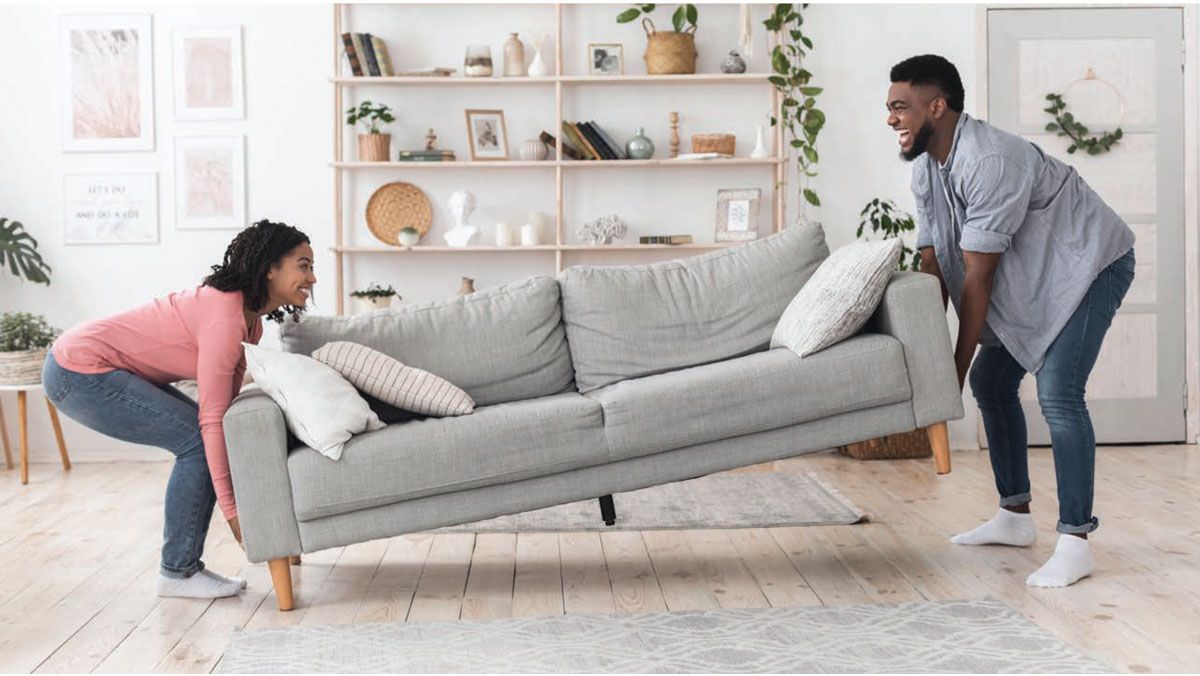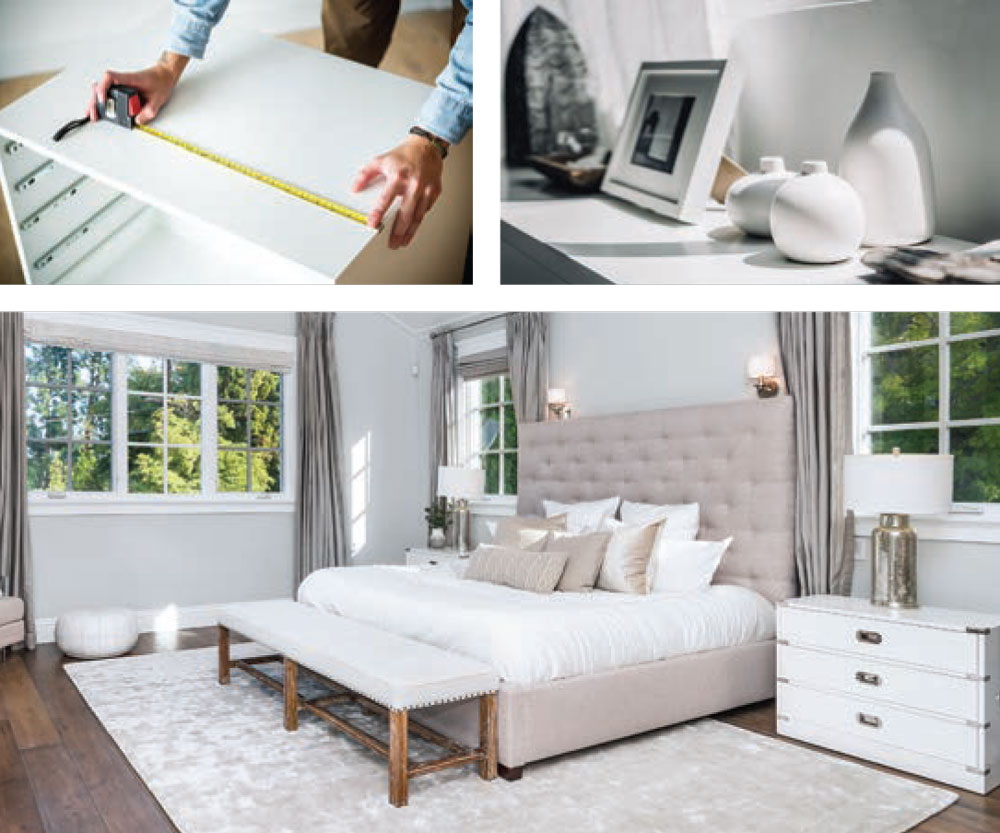REVITALIZE YOUR SPACE

The art of rearranging furniture
In the hustle and bustle of daily life, our homes often become static environments, with furniture layouts remaining unchanged for years. Yet, a simple rearrangement of your existing pieces can breathe new life into your living space, transforming its ambience and enhancing its usability and traffic flow. Whether you’re looking to refresh your home’s aesthetic or optimize its functionality, here’s a guide to help you navigate the process effectively.
Rearranging furniture is a cost-effective way to revamp your home without breaking the bank. It allows you to discover new possibilities within your existing space, fostering creativity and a sense of novelty. Moreover, optimizing traffic flow — how people move throughout your home — can greatly improve daily living, making rooms feel more spacious and functional.
MOVING TOOLS
These helpers can make your rearranging easier:
- MagicSliders
- Felt furniture pads
- Wobble Wedges (shims)
- Furniture dolly
- Minwax scratch repair/touchup markers (in case you bump the walls!)
Getting started
Before diving into the rearrangement process, take time to envision the desired outcome. Consider how you use each room and identify any specific issues with traffic flow or functionality. Clear the space of clutter to get a clearer picture of the available room and its potential layouts.

Practical tips
MEASURE TWICE, MOVE ONCEMeasure your furniture and the room dimensions carefully before moving anything. This prevents the frustration of realizing the sofa won’t fit through a doorway or that your proposed layout doesn’t leave enough walking space.
FOCUS ON FOCAL POINTSIdentify and highlight key features in each room. A fireplace, large window or built-in shelving can all be an inviting focal point. Sometimes, all it takes is updating the décor on your mantel, bookcases or coffee table to transform a space. Local home stager, downsizing expert and estate sale coordinator Debbie Asbury recommends, “Take inspiration from unexpected sources, such as magazines and stores with clever retail displays. Once you have your thoughts gathered, visit a thrift shop or antique store and see what speaks to you. Or, better yet, ‘shop your own home’ to find a forgotten or overlooked treasure!”
DIRECT THE TRAFFIC FLOW
Ensure there are clear pathways through rooms and between furniture pieces. Avoid placing large pieces of furniture in the middle of a path or too-near a doorway and make sure nobody has to do an awkward tango between furnishings. Generally, you will want to allow a space of 30″ between furniture you need to walk around and maintain 18″ between a coffee table and sofa. Dining rooms need a minimum of 36″ from table to walls so diners can move their chairs comfortably. Experts say the ideal TV placement is 8 to 12 feet away from seating, and at an angle of no greater than 30 degrees. Thus, depending on the height of your mantel, above-the-fireplace may not be the best spot for your TV. Bedrooms need at least 2 feet on either side of the bed to assist with easy bedmaking. Rugs help direct traffic and anchor a floating furniture arrangement, too. Ideally at least the front legs of furniture will fit on the rug, if not all the legs. Bedroom rugs should extend at least 2 feet on either side and at the foot of the bed.
CREATE CONVERSATION AREAS
Arrange seating in clusters to facilitate conversation, especially in long/narrow rooms. Place chairs and sofas facing each other to encourage interaction and create a cozy atmosphere.
EXPERIMENT WITH ANGLES
In an irregularly shaped room, it can be tricky to decide where and how to place furniture. Don’t limit yourself to placing furniture against or parallel to walls. Sometimes, angling a piece creates a more dynamic and spacious feel in a room.BALANCE AND SYMMETRY
Aim for balance in your furniture arrangements. Mix large and small pieces to create visual interest while maintaining symmetry where possible to promote harmony within the room. Pay attention to how furniture is distributed in the room to prevent a seesaw of heavy-on-one-end and light-on-the-other imbalance. Keep lighting on the same visual planes to avoid a dizzying zigzag of lampshades and lightbulbs.
Pitfalls to avoid
OVERCROWDING
Resist the temptation to jam too much furniture into a space.
IGNORING FUNCTIONALITY
While aesthetics are important, ensure the rearranged layout supports how you actually use the space. Bookshelves are Asbury’s favorite functional furniture. “Bookshelves are one of the most versatile pieces to purchase and use, and I find they are one of the most underrated pieces at an estate sale, which is a shame. Bookcases can be tucked next to a chair for reading. They are great in an entryway for storage, as well as a great key catcher by the front door. They are also perfect to move into a closet for sweaters and shoes.”
FORGETTING SCALE
Oversized pieces can overwhelm a small space, while tiny furniture might get lost in a large room. Pay attention to the height of chair and sofa arms relative to their side and accent tables. Bedside tables should be at or above the height of the mattress.
LACKING VARIETY
Aim for a mix of furniture shapes and heights to add visual diversity. Asbury reflects, “I got [my business] started by helping friends and family with specific tasks when they were feeling stuck. I’m not afraid to take risks in thinking outside the box, and I’m not married to the idea that someone’s belongings only have the same use they’ve always had. It’s difficult to see your own house the way someone else sees it. I experience this in my own house all the time. I can definitely get stuck! But having a fresh pair of eyes and an outside perspective can really help you unlock new ideas. It can help you fall in love with your home again!”
NEGLECTING LIGHTING
Consider how natural and artificial light interacts with your new furniture arrangement. Ensure that lighting sources are well-distributed, and that no seating area is left in a shadow.
Once you’ve settled on a new furniture arrangement, take a moment to appreciate the transformation. A well-planned rearrangement can make your home feel fresh and inviting, enhancing both its functionality and aesthetic appeal.
It’s also a chance to rediscover forgotten treasures or reimagine items in new contexts. Borrow from other rooms – a new setting can give both large pieces and small accents a brand-new life! Try an old bedroom dresser as a TV stand; move a foyer console to your bedside, use a stack of coffee table books as a tray and pull up a kitchen stool next to your favorite cozy chair.
Asbury explains, “An antique silver pitcher that will never be used for serving beverages can suddenly become a vase for fresh flowers. Clear those old pieces out of the back of your cabinet and see where they can take on a new purpose.” Jokingly, she adds, “And, bonus – you’ll now have more cabinet space available!”
Asbury continues, “Using a piece of furniture in the ‘wrong’ room is such a clever way to update a space. For instance, why can’t a dining room hutch be moved to the den and set up as a bar or a TV cabinet? Or a glass curio cabinet moved to the bath as a holder for linens, jewelry, and perfume?”
Rearranging furniture is a powerful tool for refreshing your living space and achieving a balanced, functional layout that enhances your everyday living. This fall is the perfect time to embrace the opportunity to experiment and enjoy the process of transforming your home for the busy holiday season ahead. ✦
angle, balance and symmetry, conversation areas, focal points, functionality, lighting, measure, overcrowding, rearranging furniture, scale, traffic flow, variety










